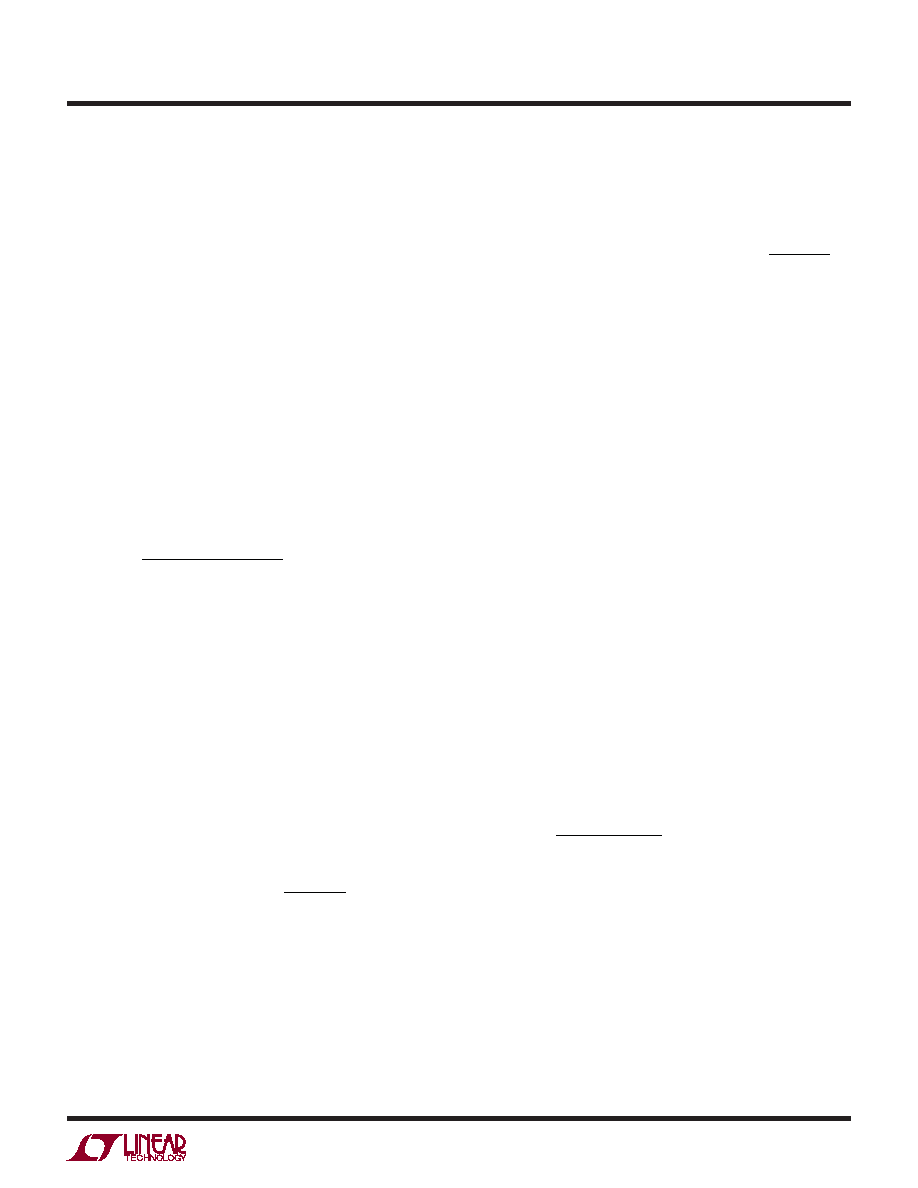- 您現(xiàn)在的位置:買賣IC網(wǎng) > PDF目錄44987 > LT3958IUHE#PBF (LINEAR TECHNOLOGY CORP) SWITCHING REGULATOR, PQCC36 PDF資料下載
參數(shù)資料
| 型號(hào): | LT3958IUHE#PBF |
| 廠商: | LINEAR TECHNOLOGY CORP |
| 元件分類: | 穩(wěn)壓器 |
| 英文描述: | SWITCHING REGULATOR, PQCC36 |
| 封裝: | 5 X 6 MM, LEAD FREE, PLASTIC, QFN-36 |
| 文件頁數(shù): | 11/28頁 |
| 文件大?。?/td> | 320K |
| 代理商: | LT3958IUHE#PBF |
第1頁第2頁第3頁第4頁第5頁第6頁第7頁第8頁第9頁第10頁當(dāng)前第11頁第12頁第13頁第14頁第15頁第16頁第17頁第18頁第19頁第20頁第21頁第22頁第23頁第24頁第25頁第26頁第27頁第28頁

LT3958
19
3958f
APPLICATIONS INFORMATION
Compared to the yback converter, the SEPIC converter
has the advantage that both the power MOSFET and the
output diode voltages are clamped by the capacitors (CIN,
CDC and COUT), therefore, there is less voltage ringing
across the power MOSFET and the output diodes. The
SEPIC converter requires much smaller input capacitors
than those of the yback converter. This is due to the fact
that, in the SEPIC converter, the current through inductor
L1 (which is series with the input) is continuous.
SEPIC Converter: Switch Duty Cycle and Frequency
For a SEPIC converter operating in CCM, the duty cycle
of the main switch can be calculated based on the output
voltage (VOUT), the input voltage (VIN) and the diode
forward voltage (VD).
The maximum duty cycle (DMAX)occurswhentheconverter
has the minimum input voltage:
DMAX =
VOUT + VD
VIN(MIN) + VOUT + VD
SEPIC Converter: The Maximum Output Current
Capability and Inductor Selection
As shown in Figure 1, the SEPIC converter contains two
inductors: L1 and L2. L1 and L2 can be independent, but
can also be wound on the same core, since identical volt-
ages are applied to L1 and L2 throughout the switching
cycle.
For the SEPIC topology, the current through L1 is the
converter input current. Based on the fact that, ideally, the
output power is equal to the input power, the maximum
average inductor currents of L1 and L2 are:
IL1(MAX) =IIN(MAX) =IO(MAX)
DMAX
1DMAX
IL2(MAX) =IO(MAX)
In a SEPIC converter, the switch current is equal to IL1 +
IL2 when the power switch is on, therefore, the maximum
average switch current is dened as:
ISW(MAX) =IL1(MAX) +IL2(MAX) =IO(MAX)
1
1DMAX
Due to the current limit of its internal power switch,
the LT3958 should be used in a SEPIC converter whose
maximum output current (IO(MAX)) is less than the output
current capability by a sufcient margin (10% or higher
is recommended):
IO(MAX) < (1 – DMAX) (3.3A – 0.5 ΔISW)
The inductor ripple currents
ΔIL1 and ΔIL2 are identical:
ΔIL1 = ΔIL2 = 0.5 ΔISW
The inductor ripple current
ΔISW has a direct effect on the
choice of the inductor value and the converter’s maximum
output current capability. Choosing smaller values of
ΔISW
requires large inductances and reduces the current loop
gain (the converter will approach voltage mode). Accepting
larger values of
ΔISW allows the use of low inductances,
but results in higher input current ripple and greater core
losses and reduces output current capability. It is recom-
mended to choose a
ΔISW higher than 0.6A.
Given an operating input voltage range, and having chosen
the operating frequency and ripple current in the induc-
tor, the inductor value (L1 and L2 are independent) of the
SEPIC converter can be determined using the following
equation:
L1=L2 =
VIN(MIN)
1.5A ΔISW
DMAX
For most SEPIC applications, the equal inductor values
will fall in the range of 1μH to 100μH.
相關(guān)PDF資料 |
PDF描述 |
|---|---|
| LT3958EUHE#PBF | SWITCHING REGULATOR, PQCC36 |
| LT3958EUHE#TRPBF | SWITCHING REGULATOR, PQCC36 |
| LT4180MPGN#PBF | POWER SUPPLY SUPPORT CKT, PDSO24 |
| LT4180IGN#PBF | POWER SUPPLY SUPPORT CKT, PDSO24 |
| LT4180EGN#TRPBF | POWER SUPPLY SUPPORT CKT, PDSO24 |
相關(guān)代理商/技術(shù)參數(shù) |
參數(shù)描述 |
|---|---|
| LT3958IUHETRPBF | 制造商:LINER 制造商全稱:Linear Technology 功能描述:High Input Voltage, Boost, Flyback, SEPIC and Inverting Converter |
| LT3959 | 制造商:LINER 制造商全稱:Linear Technology 功能描述:Wide Input Voltage Range Boost/SEPIC/Inverting Converter with 6A, 40V Switch |
| LT3959EFE#PBF | 制造商:Linear Technology 功能描述:IC REG MULTI CONFIG ADJ 38TSSOP |
| LT3959EFE#PBF | 制造商:Linear Technology 功能描述:DC-DC CONV BOOST/INVERTING TSSOP-38 制造商:Linear Technology 功能描述:DC-DC CONV, BOOST/INVERTING, TSSOP-38 |
| LT3959EFE#TRPBF | 制造商:Linear Technology 功能描述:IC REG MULTI CONFIG ADJ 38TSSOP |
發(fā)布緊急采購,3分鐘左右您將得到回復(fù)。